AI Research
Antarctic Ocean secrets hidden in layers of seafloor mud

Science correspondent, BBC News
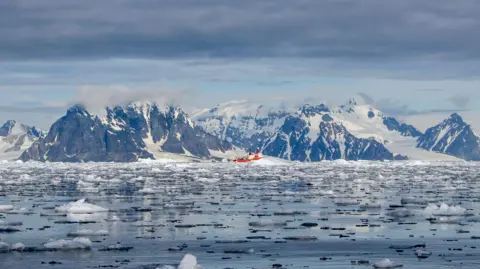 Elisenda Balleste
Elisenda BallesteBBC News science team
Why would anyone brave hand-numbing cold, icy winds and rough seas – sometimes working through the night – to dig up mud from the Antarctic seabed?
That is what an international team of particularly adventurous researchers did earlier this year in the remote Antarctic Peninsula, on a mission aiming to reveal centuries of scientific secrets about the Southern Ocean.
Scientists around the world will now share and analyse these precious mud samples to work out how human activity – including a century of industrial whaling – affected Antarctica and the rest of our planet.
The research is part of a global effort to understand the relationship between the ocean and the climate.
 Elisenda Balleste
Elisenda BallesteA history of ocean life
Researchers used a special coring drill – a bit like a huge apple-corer – tethered to a research ship, to drill at depths of up to 500m.
They collected more than 40 long cores, or tubes, of seafloor sediment from locations around the peninsula.
This is one of the richest habitats for marine life in Antarctica, and a focal point for fishing, tourism and – before it was banned in the 1980s – industrial whale hunting.
Collecting the sediment gives insight and clues to the past, “like a book of history”, explained lead researcher Dr Elisenda Balleste from the University of Barcelona.
“What is living in the seas now, what was living in the seas in the past and evidence of our human impact” is recorded in layer upon layer of sediment over centuries, she said.
By preserving and dating those layers, and analysing what they contain, researchers can build a picture of the history of Antarctic marine life.
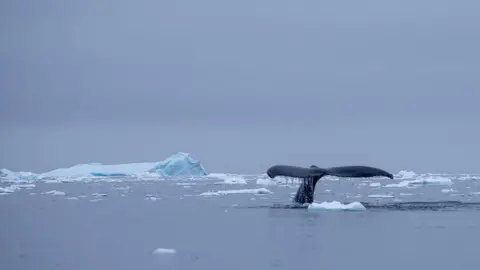 Victoria Gill/BBC
Victoria Gill/BBCOnce on board the ship, the cores were frozen and transported to Barcelona and Dr Balleste’s laboratory.
From there, carefully extracted pieces of this Antarctic mud will be sent out to several academic institutions around the world.
Scientists will scan and date the sediment layers, work out what microbial life they contain, measure levels of pollution and calculate how much carbon is buried in the mud.
It is part of a mission – the Convex Seascape Survey – which involves universities and research institutions around the globe working together to better understand how our ocean and climate are connected.
Claire Allen, an oceanographer from the British Antarctic Survey who has studied Antarctica’s past for more than 20 years, said that cores like these were particularly valuable.
“Before 1950 – before there was any kind of monitoring capacity in Antarctica – sediment cores and ice cores are the only way that we can get an insight into any of the climatic or physical properties that have changed over time,” she said.
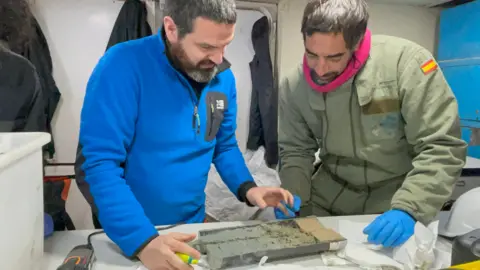 Elisenda Balleste
Elisenda BallesteThe DNA fingerprint from whale hunting
The newly collected samples being stored for DNA analysis have to be kept at temperatures low enough to stop all biological processes.
Dr Balleste took them out of the industrial-sized freezer where they are being stored to show them to us, very briefly.
“They’re kept at minus 80 degrees to stop them degrading,” she explained.
These small pieces of the seabed – frozen in time at temperatures that preserve genetic material – will be used for what is known as environmental DNA analysis.
It is an area of science which has developed rapidly in recent years. It gives researchers the ability to extract genetic information from water, soil and even air, like a fingerprint of life left behind in the environment.
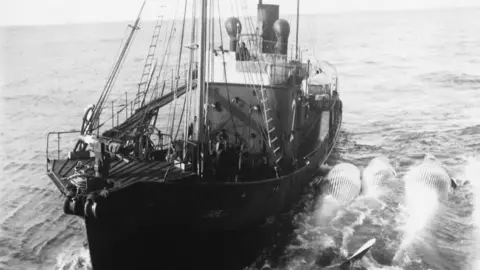 Getty Images
Getty ImagesDr Carlos Preckler, from King Abdullah University in Saudi Arabia, is leading this part of the research and will be trying to measure how almost a century of industrial whaling in Antarctica affected the ocean and our atmosphere.
Carbon – when it is released into the atmosphere as carbon dioxide – warms up our planet like a blanket.
So, as the world struggles to reduce those emissions, any processes that absorb and lock significant amounts of carbon might help to rein in global warming.
“We know whales have a lot of carbon in their bodies, because they are huge animals,” said Dr Preckler.
What he and his colleagues want to know is how much of that carbon gets buried in the seafloor – and locked away from the atmosphere – when the animals die.
“We can measure whale DNA and the carbon in the sediment,” explained Dr Preckler.
“So we can measure what happened before industrial whaling removed most of the whales in the [Southern] ocean,” he added.
That, the researchers say, will provide a measure of how much whales – simply by existing, being huge and living out their natural lives – remove carbon from our atmosphere and help in the fight against climate change.
AI Research
Study shakes Silicon Valley: Researchers break AI
Study shows researchers can manipulate chatbots with simple psychology, raising serious concerns about AI’s vulnerability and potential dangers.

AI Research
And Sci Fi Thought AI Was Going To… Take Over? – mindmatters.ai
AI Research
Measuring Machine Intelligence Using Turing Test 2.0
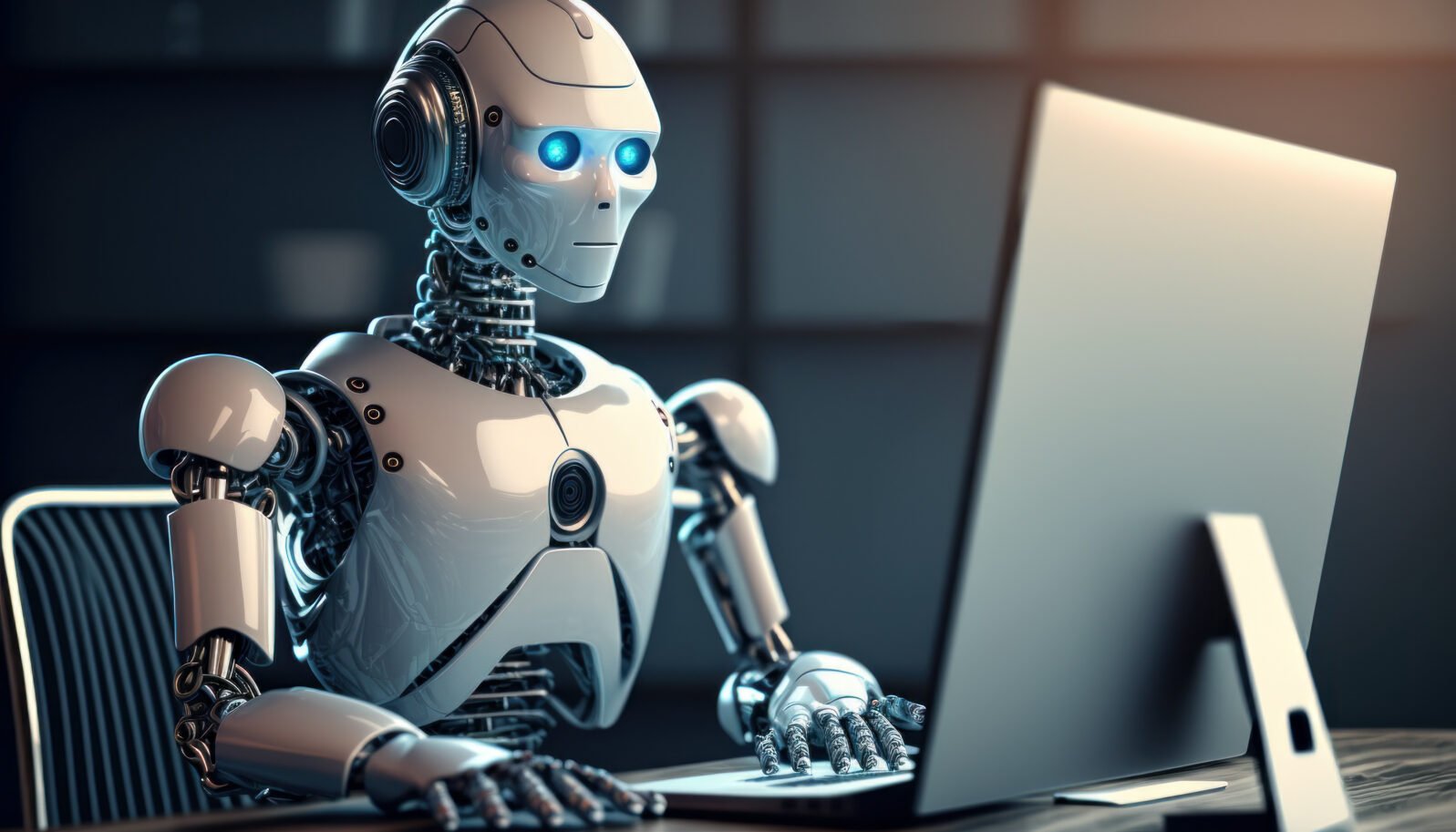
In 1950, British mathematician Alan Turing (1912–1954) proposed a simple way to test artificial intelligence. His idea, known as the Turing Test, was to see if a computer could carry on a text-based conversation so well that a human judge could not reliably tell it apart from another human. If the computer could “fool” the judge, Turing argued, it should be considered intelligent.
For decades, Turing’s test shaped public understanding of AI. Yet as technology has advanced, many researchers have asked whether imitating human conversation really proves intelligence — or whether it only shows that machines can mimic certain human behaviors. Large language models like ChatGPT can already hold convincing conversations. But does that mean they understand what they are saying?
In a Mind Matters podcast interview, Dr. Georgios Mappouras tells host Robert J. Marks that the answer is no. In a recent paper, The General Intelligence Threshold, Mappouras introduces what he calls Turing Test 2.0. This updated approach sets a higher bar for intelligence than simply chatting like a human. It asks whether machines can go beyond imitation to produce new knowledge.
From information to knowledge
At the heart of Mappouras’s proposal is a distinction between two kinds of information, non-functional vs. functional:
- Non-functional information is raw data or observations that don’t lead to new insights by themselves. One example would be noticing that an apple falls from a tree.
- Functional information is knowledge that can be applied to achieve something new. When Isaac Newton connected the falling apple to the force of gravity, he transformed ordinary observation into scientific law.
True intelligence, Mappouras argues, is the ability to transform non-functional information into functional knowledge. This creative leap is what allows humans to build skyscrapers, develop medicine, and travel to the moon. A machine that merely rearranges words or retrieves facts cannot be said to have reached the same level.
The General Intelligence Threshold
Mappouras calls this standard the General Intelligence Threshold. His threshold sets a simple challenge: given existing knowledge and raw information, can the system generate new insights that were not directly programmed into it?
This threshold does not require constant displays of brilliance. Even one undeniable breakthrough — a “flash of genius” — would be enough to demonstrate that a machine possesses general intelligence. Just as a person may excel in math but not physics, a machine would only need to show creativity once to prove its potential.
Creativity and open problems
One way to apply the new test is through unsolved problems in mathematics. Throughout history, breakthroughs such as Andrew Wiles’s proof of Fermat’s Last Theorem or Grigori Perelman’s solution to the Poincaré Conjecture marked milestones of human creativity. If AI could solve open problems like the Riemann Hypothesis or the Collatz Conjecture — problems that no one has ever solved before — it would be strong evidence that the system had crossed the threshold into true intelligence.
Large language models already solve equations and perform advanced calculations, but solving a centuries-old unsolved problem would show something far deeper: the ability to create knowledge that has never existed before.
Beyond symbol manipulation
Mappouras also draws on philosopher John Searle’s famous “Chinese Room” thought experiment. In the scenario, a person who does not understand Chinese sits in a room with a rulebook for manipulating Chinese characters. By following instructions, the person produces outputs that convince outsiders he understands the language, even though he does not.
This scenario, Searle argued, shows that a computer might appear intelligent without real understanding. Mappouras agrees but goes further. For him, real intelligence is proven not just by producing outputs, but by acting on new knowledge. If the instructions in the Chinese Room included a way to escape, the person could only succeed if he truly understood what the words meant. In the same way, AI must demonstrate it can act meaningfully on information, not just shuffle symbols.
Can AI pass the new test?
So far, Mappouras does not think modern AI has passed the General Intelligence Threshold. Systems like ChatGPT may look impressive, but their apparent creativity usually comes from patterns in the massive data sets on which they were trained. They have not shown the ability to produce new, independent knowledge disconnected from prior inputs.
That said, Mappouras emphasizes that success would not require constant novelty. One true act of creativity — an undeniable demonstration of new knowledge — would be enough. Until that happens, he remains cautious about claims that today’s AI is truly intelligent.
A shift in the debate
The debate over artificial intelligence is shifting. The original Turing Test asked whether machines could fool us into thinking they were human. Turing Test 2.0 asks a harder question: can they discover something new?
Mappouras believes this is the real measure of intelligence. Intelligence is not imitation — it is innovation. Whether machines will ever cross that line remains uncertain. But if they do, the world will not just be talking with computers. We will be learning from them.
Final thoughts: Today’s systems, tomorrow’s threshold
Models like ChatGPT and Grok are remarkable at conversation, summarization, and problem-solving within known domains, but their strengths still reflect pattern learning from vast training data. By Mappouras’s standard, they will cross the General Intelligence Threshold only when they produce a verifiable breakthrough — an insight not traceable to prior text or human scaffolding, such as an original solution to a major open problem. Until then, they remain powerful imitators and accelerators of human work — impressive, useful, and transformative, but not yet creators of genuinely new knowledge.
Additional Resources
-

 Business2 weeks ago
Business2 weeks agoThe Guardian view on Trump and the Fed: independence is no substitute for accountability | Editorial
-
Tools & Platforms1 month ago
Building Trust in Military AI Starts with Opening the Black Box – War on the Rocks
-

 Ethics & Policy2 months ago
Ethics & Policy2 months agoSDAIA Supports Saudi Arabia’s Leadership in Shaping Global AI Ethics, Policy, and Research – وكالة الأنباء السعودية
-

 Events & Conferences4 months ago
Events & Conferences4 months agoJourney to 1000 models: Scaling Instagram’s recommendation system
-

 Jobs & Careers3 months ago
Jobs & Careers3 months agoMumbai-based Perplexity Alternative Has 60k+ Users Without Funding
-

 Podcasts & Talks2 months ago
Podcasts & Talks2 months agoHappy 4th of July! 🎆 Made with Veo 3 in Gemini
-

 Education2 months ago
Education2 months agoVEX Robotics launches AI-powered classroom robotics system
-

 Education2 months ago
Education2 months agoMacron says UK and France have duty to tackle illegal migration ‘with humanity, solidarity and firmness’ – UK politics live | Politics
-

 Podcasts & Talks2 months ago
Podcasts & Talks2 months agoOpenAI 🤝 @teamganassi
-

 Funding & Business3 months ago
Funding & Business3 months agoKayak and Expedia race to build AI travel agents that turn social posts into itineraries



